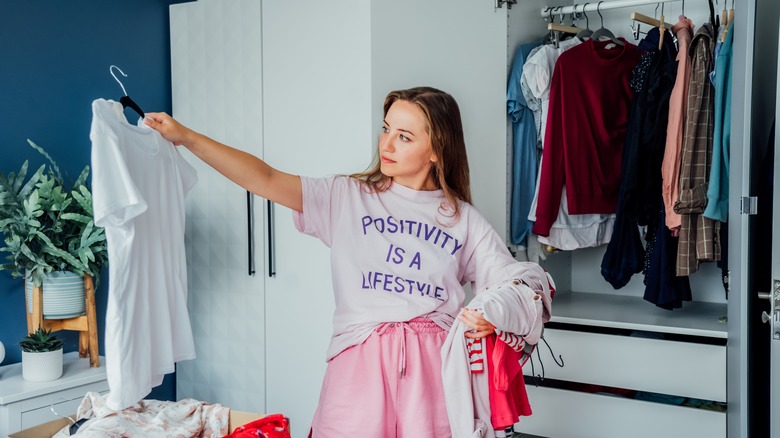Wardrobe Inventory: How To Create One (& Why You Need It)
Ever spent hours trying to choose something to wear from your wardrobe, only to end up feeling defeated and totally overwhelmed (and possibly canceling your plans so you can stay home and just wear your sweats)? If you're like most people, this paralysis isn't due to a lack of clothes. Often, it comes from a lack of closet organization. You can have the best wardrobe in the world, but if you don't track it, picking your fits will be a daunting task.
Luckily, there's a simple way to keep your clothes organized and fresh in your mind: a wardrobe inventory. Like any other inventory, this simply involves making a detailed record of all your clothes, jotting down the important information surrounding them, and sorting them out into helpful categories. As Apartment Therapy explains, there are apps you can use to help you create a wardrobe inventory, but you can also make one from scratch. It will require some time and effort, but when you have a clear wardrobe inventory to refer to, you'll know what clothes you have to choose from, what items you can recycle, and what kind of pieces you should invest in for the future.
List every single garment you own
To begin creating your wardrobe inventory, pull absolutely everything out. This is the time-consuming part; you'll need to record every single item you own. Don't miss anything, even that old black cami that you never wear anymore, or the one polka dot sock that's missing its partner. Unless you find something and decide on the spot that you need to get rid of it then and there, write it down.
When you're recording your garments (and accessories, if you want to leave no stone unturned), include the price that you paid for them. Ideally, a Google search can help you if you don't remember and your items are relatively new. But when you're dealing with an older piece of clothing, use your best estimate. By including the price, you'll get an idea of how much you've spent for items that you do or don't wear often, and thus discover what is valuable and what was a waste of money.
A Considered Life recommends including an image of the clothing item beside each entry. If you're a visual person, this will help you to create the best outfits in your mind, using what items you have already, without needing to pull out every single thing in your wardrobe.
Categorize them in a way that makes sense to you
Once you've recorded every garment you own in your inventory, you can categorize them. Our minds all work slightly differently, so you can do this in whatever way feels right to you. From a logical standpoint, it makes sense to group your clothing items by formality, as in formal, semi-formal, and casual. You could also categorize them by the actual items that they are, so you'll have pants, tops, dresses, outerwear, and so on, or you can categorize them by color.
If you don't create groups based on these factors, it's still important to record these details beside each entry. That means writing down what color each item is, what piece of clothing it actually is, and whether it's formal, casual, or versatile. It's also a good idea to write down how often you wear the item. Again, this will give you an idea of whether you're actually getting a return on your investment.
Take into account clothes in storage and seasonal items
This is where the inventory process gets slightly messier. Don't forget about those items that aren't in your wardrobe for whatever reason. Maybe you've loaned a dress to a friend or your favorite black leather jacket is still in your sister's closet after she borrowed it last winter. Take the time to account for every single thing you own, whether or not they're physically in your wardrobe.
A common reason why clothes might be in storage rather than in your wardrobe is the changing seasons. When you've got limited space, not many people can afford to have their summer dresses taking up wardrobe real estate in the winter, and vice versa. So don't forget about seasonal clothes you might have packed away.
Also note which clothes are seasonal on your inventory. If you haven't worn a coat for six months, specify whether it's because the coat doesn't go with anything else you own, or whether the weather just hasn't been appropriate.
Note history and emotional connections
By now, you should have all of your clothes listed in your inventory, categorized in a way that makes sense to you, and with accompanying details that shed light on how important each piece is in your wardrobe and how you might style it. The next step is to add some information to every entry that's a little less black-and-white.
Every garment tells a story, whether you bought it during one of your travels abroad, scored it for a bargain, or kept it from a relationship that didn't work out. Jot down the history of each clothing item along with any emotional association you have with it. While the point of a wardrobe inventory is to be more clear and informed when it comes to shopping and dressing yourself, the reality is not every decision you make will be practical. There might be a skirt that you never wear, doesn't go with anything else you own, and is just taking up space. But still, throwing it out might not be the best thing if it's the skirt you wore to your college graduation.
Why you need a wardrobe inventory
The most obvious advantage of a wardrobe inventory is that it allows you to clearly see all your clothing choices without needing to turn your wardrobe upside down the next time you're planning a fit for an event. For this reason, it's especially helpful to include photos. But also, the information that you'll record alongside every item will allow you to identify which clothes you might want to get rid of, and what is worth spending your money on in the future.
Noting the price, history, and wearing history of each piece will teach you about your own habits and uncover a go-to style that you might not have been aware of. Maybe you'll discover that black jeans are worth paying more for because you can pair them with anything and you've worn them consistently for the last year. You could realize that you wear the heck out of puffy sleeves, so you'll always have room for more. Or you might find that even though you love the idea of colorblocking in your wadrobe, you haven't worn any of the bright colors that you already own. Additionally, tracking your clothes like this will highlight those capsule wardrobe staples that you need, but are missing.
If the idea of creating an inventory is still daunting, you can use free templates that are available from websites like Seamwork. But don't be afraid to experiment with different layouts and add your own ideas. A wardrobe inventory can change your life, and the most effective models will suit your personality and unique way of seeing the world.





